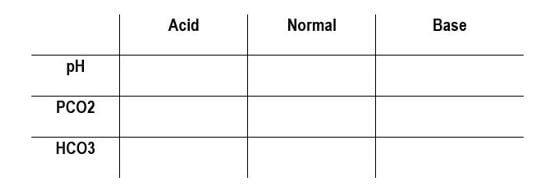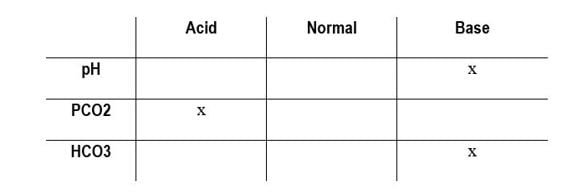Understanding blood gases and acid base can be tricky for most students to get the hang of, but once you’ve got it, you’ve got it!
There are many tips and strategies to help you, from mnemonics, to charts, to lectures, to practice, so we’ve taken the best and put them into one easy-to-understand Arterial Blood Gases study tool!
Normal Values
First things first. Know your normal and abnormal ABG values when you look at your lab reports.
Acidosis or Alkalosis
The acidity of the blood is determined by the value of the pH, and should be the first thing you determine when checking ABG results.
Respiratory or Metabolic
Next you need to determine if the acid base is Respiratory or Metabolic.
pCO2 = Respiratory
HCO3 = Metabolic
ROME
So what’s an easy way to remember how to put the values together? The mnemonic ROME.
Respiratory Opposite
When pH is up, pCO2 is down = Alkalosis
When pH is down, PCO2 is up = Acidosis
Metabolic Equal
When pH is up, HCO3 is up = Alkalosis
When pH is down, HCO3 is down = Acidosis
Tic Tac Toe
Now it’s time to make Acid Base more fun. Remember our normal ABG value chart? It’s time to make some blank ones of your own – a bit like a tic tac toe chart. Feel free to print out copies of this one.
When you get a set of ABGs back, mark them on your Tic Tac Toe chart. Let’s try it with this example.
pH 7.29, PCO2 22, HCO3 14
- pH is LOW = ACID so place an ‘x’ next to pH under Acid
- PCO2 is LOW = BASE so place an ‘x’ next to PCO2 under Base
- HCO3 is LOW = ACID so place an ‘x’ next to HCO3 under Acid
Your chart should now look like this;
Now look at which column matches up with the pH. In this case it’s HCO3 = Metabolic, and both are under Acid, so this example indicates Metabolic Acidosis.
Compensated, Partially Compensated, or Uncompensated
There is one more aspect of ABGs you need to understand. Whether or not the kidneys or lungs are compensating for the imbalance. A simple rule of thumb is as follows;
- Compensated = pH is NORMAL, PCO2 and HCO3 are both ABNORMAL
- Partially Compensated = pH is ABNORMAL, PCO2 and HCO3 are both ABNORMAL
- Uncompensated = pH is ABNORMAL, PCO2 or HCO3 is ABNORMAL
Using you blank chart again, determine what the following ABG means.
pH 7.51, PCO2 49, HCO3 35
- pH is HIGH = BASE so place an ‘x’ next to pH under Base
- PCO2 is HIGH = ACID so place an ‘x’ next to PCO2 under Acid
- HCO3 is HIGH = BASE so place an ‘x’ next to HCO3 under Base
Your chart should look like this;
pH is Base (Alkalosis). The value that is in the same column as pH is HCO3, which indicates Metabolic Alkalosis, and the PCO2 is also abnormal. When all three values are abnormal, it indicates Partial Compensation.
Therefore this ABG is partially compensated Metabolic Alkalosis.











